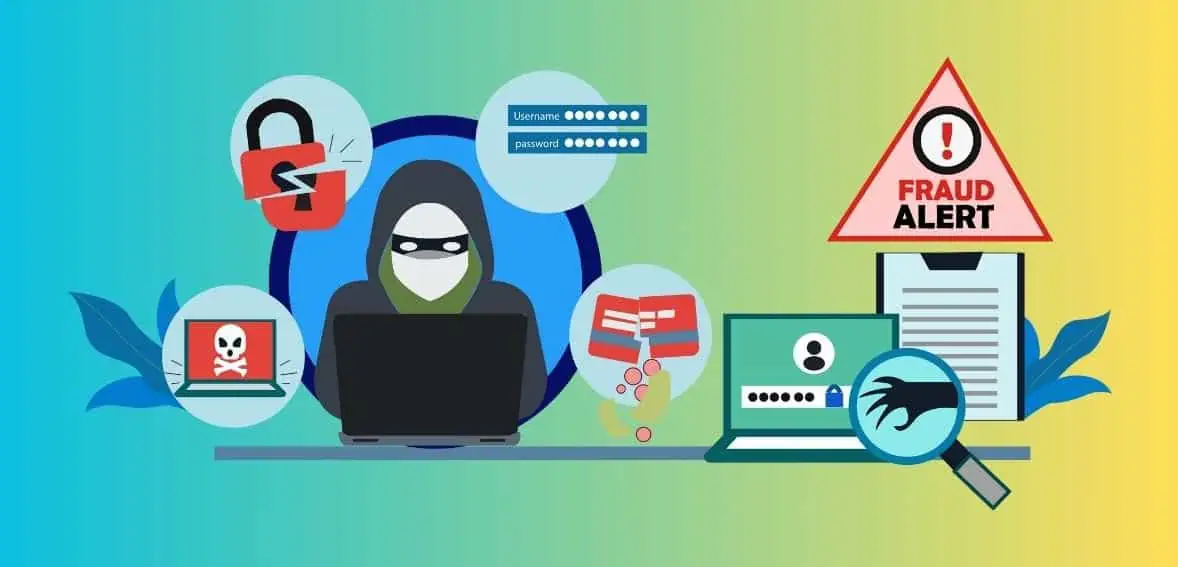With the advancement of technology, fraud cases are still on the rise, and sellers are unfortunately falling victim to financial losses. While we often hear about different types of fraud, merchant fraud tends to go unnoticed. It has become a problem for businesses and consumers, significantly impacting their profits, financials, and identity! Recent data indicates that large and sized retailers have experienced an increase of approximately 48%, while small businesses have seen a rise of around 27% compared to last year’s figures.
Despite its seriousness, merchant fraud detection does not receive attention. Its complexities and complications in payments make it challenging to track and combat effectively. The efforts aimed at curbing activities only sometimes yield the desired outcomes. This article seeks to shed light on the forms of merchant account fraud and provide tips for mitigating its impact.
What’s Merchant Account Fraud?

Merchant fraud can negatively impact businesses when deceitful people use underhanded methods to take advantage of those processing payments and using payment systems. These scammers are quite skilled at secretly getting into innocent merchant accounts without permission, cleverly changing transactions to divert well-earned funds from honest companies. Their main motive is to try to steal money using multiple deceptive ways, including credit card fraud, identity theft, phishing scams, and account takeover. This is often hard to spot until it’s too late when the fraudster has already taken the money and disappeared.
The effects of merchant fraud spread widely, directly influencing businesses and simultaneously targeting whole industries. To be clear, Merchant fraud is a crime involving a single person or a group trying to trick payment systems, creating disruptions for businesses and shoppers.
How Does Merchant Account Fraud Work?
Fundamentally, merchant fraud is an illegal action in which an individual or a group uses payment systems to deceive companies and consumers. This activity can hurt weak spots in different payment methods. Hence, small business owners must know these tricks when accepting online payments. There are various ways merchant fraud happens nowadays. It could be a merchant using deceitful tactics to rob a customer or a scam targeting the merchants themselves.
Scams could present themselves in many different masks. For instance, con artists could set up fake online shops or social media profiles imitating real businesses. This fools customers into thinking they’re buying from a trusted source. These false storefronts might display products at low costs or advertise “one-of-a-kind” items to attract unaware shoppers.
However, most of the products on these online platforms are fake. Using clever tricks, they fool people into buying replica items. They make phony product listings, using excellent and attractive photos to make them look natural and safe. But it’s just a trick. If you order something thinking it’s real, you might end up with a cheap item.
Ultimately, their motive is clear: once a customer buys something, the fraudsters might ship a fake or subpar product, or worse, they may not send anything at all. Sometimes, they might misuse the client’s credit card information for future scams, costing more money. Recognizing these methods can be a critical tool for companies to handle online payments.
Different Types Of Merchant Account Frauds

Merchant fraud is becoming a growing problem as new scams emerge daily. So, let’s delve into some of the fraudulent schemes.
- Identity Theft:
It occurs when individuals deceitfully gather your information, like your name, address, and Social Security number, to use it. Despite the advancements, in 2024, this issue continues to persist and threatens consumers and businesses.
Imagine waking up one morning and discovering that someone is pretending to be you and misusing your money. By creating a new identity, they exploit an existing one, allowing them to make online purchases under a fake identity or use someone else’s credit card details to make unauthorized transactions. In such situations, credit cards are particularly vulnerable as fraudsters only need information to carry out transactions where the card is not physically present with keyed-in transactions.
- Hidden Fees:
Many companies are competing with each other in the crowded field of online payments, all chasing slim profits from handling transactions. Instead of technological advancements, these firms have developed new ways of marketing and selling their services in response to stiff competition. Payment firms often use magnetic headline rates, complex contracts, and baffling years-long contracts to lure online store owners. You can easily be misguided by these approaches, layered with excess professional terminology, and end up binding yourself in deals that hide the actual cost they’re bearing.
An array of obscure add-on charges, such as authorization fees, monthly statement fees, transaction processing fees, and termination fees, usually tucked away in the legal small print, are prevalent in such practices.
- Bait-and-Switch Scam:
Salespeople can use sneaky methods during sales calls. They might at first hint at low costs with tons of fantastic add-on services, only to unveil more considerable fees later when the bill comes to your doorstep. It’s vital to watch out for unexpected calls and check well on any service giver before going with their services. These salespersons use the “sunk cost” thought error.
This is when people choose to go ahead with something they’ve put time and money into, even when it might be against their best interests. Some people might sit through a movie they started, even if they aren’t enjoying it.
With such tricks, the seller leverages the buyer’s feeling of having invested already. They count on having already dedicated time, which will make it easier for them to stick around instead of looking for a better option for the product initially advertised.
- Triangulation Fraud:
Triangulation fraud is a type of online scam that few people know about. It involves three main characters: a scammer, an innocent customer, and a real business. The scammer sets up a fake online shop displaying items to buy, including the margins. The customer orders something from this shop. Then, the scammer uses stolen credit card information to purchase the same item from a real business at a lower price, arranging for delivery to the customer. The three critical parts of this fraud are:
- Scammer’s Store: This is a fake online shop where customers unknowingly buy items.
- Legitimate Vendor: This is the actual business that sells the item displayed in the scammer’s shop, unaware it’s part of a scam.
- Customer: This person shops at the scammer’s store, not realizing the item comes from a genuine vendor and paid for with stolen credit card details.
Triangulation scams are tricky because they negatively affect both customers and genuine sellers. Customers might get their order, but they’re unwittingly part of a bogus transaction. The real business may suffer financial loss due to chargebacks and disputes.
- Account Takeover Fraud:
Account Takeover Fraud (ATO) is an identity theft where fraudsters gain control of an online account and impersonate legitimate users. Standard methods for ATO include compromised credentials, session-hijacking, social engineering, and device takeover.
Web-based shops often fall victim to ATO fraud because they hold essential financial information. Sometimes, customers must be more careful with their security on these sites. If a no-good someone gets into an online shopping account, it’s about more than just scamming with the saved card. They could see personal details – credit card info, where people live, phone numbers, and email addresses. So, this doesn’t just highlight the dangers a web store could face from ATO fraud.
It shows how ATO can be a method for stealing identities, too. The same goes for a bad guy trying to break into online banking. They might want to move money or gather enough personal identifying information (PII). Then, they can apply for a loan at a different bank using an identity they’ve stolen.
- Fake Merchant Scam:
As more businesses go online, they depend on service providers to manage their payments. But a hidden threat lurks here, too. Some fake providers pretend to be accurate. They trick companies with lies and super-low rates.
Once they fool a company, they either disappear with vital data or reveal their tricks by charging high hidden fees, hurting the company’s bottom line. That’s why all business owners must be careful when choosing a provider and check thoroughly before teaming up.
- Phishing Scam:
Phishing attempts can fool even the most careful users by disguising malicious actors as trusted contacts offering amazing deals, discounts, freebies, and even job offers to attract your attention. In such situations, attackers create messages appearing to come from legitimate sources, hoping the recipient will click embedded links or attachments. However, these tricks aim only to guide victims into compromising their security.
Dealing with the consequences of such a security breach can be challenging. People may find themselves facing unexpected charges, missing money from their accounts, or having their private details stolen and misused without consent. It’s a troubling situation for anyone to endure. Additionally, phishing is commonly leveraged as an entry point into the business systems, often comprising one piece of a more intricate assault such as a sophisticated ongoing security risk. In this scenario, personnel are manipulated to penetrate security barriers, distribute malware within a closed setting, or gain privileged admittance to protected information.
The Impact Of Merchant Fraud On Businesses And Its Customers

Fraud within businesses is a global problem that can impact various sectors differently. eCommerce businesses are mainly targeted due to the tricky nature of online transactions. Merchant fraud can also bring trouble to industries such as travel and hospitality, digital goods and services, and other high-risk sectors. This problem leads to more than financial losses; it can damage the business’s reputation. Outcomes of fraudulent activities can result in less sales and revenue potential. Trust-building efforts with customers become highly costly, as compensating for merchant fraud exposure takes time and resources.
Companies targeted by merchant fraud may also experience financial difficulties like chargebacks and penalties. The chargeback fees can vary, usually from $0 to $100, depending on the payment gateway used. If you can provide evidence of the legitimacy of a transaction, you can avoid a chargeback.
However, it’s important to note that fees may still be involved. In some cases, the potential losses include the products or services sold, the original payment amount, chargeback fees, currency conversion charges, and processing fees. Furthermore, many chargebacks can result in your merchant account being classified as “risk,” leading to higher transaction costs. On average, merchants allocate around 3-5% of their revenue towards combating fraud. Despite these efforts, 1% of orders may slip through undetected, resulting in chargebacks. It is essential to navigate these challenges to protect your business and financial interests.
Companies that do not pay enough attention to customer protection or do not have robust fraud prevention features could face legal punishment. Having strong fraud prevention measures plays a vital role in these outcomes.
The adverse effects of merchant fraud extend to consumers as well. Consumer trust in businesses and the digital payment system can also be significantly damaged. Issues created due to stolen identities or financial fraud emphasize the need for businesses to stay alert against merchant fraud to ensure safe online interactions. Moreover, processing fees often rise in industries struggling with common dealer scams. It affects every business alike.
Tips To Mitigate The Risk Of Merchant Account Fraud
Here are some essential tips to follow to prevent the risk of merchant fraud:
- Integrate fraud prevention tools:
To combat fraud activities effectively, it is crucial to incorporate various tools for fraud prevention. These tools include software designed to detect and flag ‘unusual’ transactions and systems that verify addresses and fingerprint devices.
By utilizing tools like Kount, Signifyd, Riskified, Sift, and Accertify, businesses can prevent fraudulent activities involving stolen credit card information or transactions from high-risk locations.
- Apply 3D Secure authentication:
Another effective measure to enhance security is the implementation of 3D Secure authentication. This process adds a layer of protection by requiring customers to enter a password or code during purchases to verify their identity.
By implementing this measure, businesses can significantly reduce the risk of transactions and safeguard themselves against chargebacks when customers dispute charges and seek refunds.
- Conduct fraud prevention training for employees:
Equipping employees with the knowledge and training in fraud prevention is also paramount for businesses. Staff members need to be able to recognize signs of fraud, such as customer behavior or suspicious transactions. Additionally, they should be well-versed in reporting and responding to suspected fraud incidents while ensuring the handling of information and maintaining safe payment processing practices.
- Watch for unusual patterns:
Monitoring involves scrutinizing transaction data to pinpoint patterns and irregularities that might signal suspicious activities. Businesses should closely monitor transactions displaying unusual patterns, such as multiple transactions originating from the same IP address or various transactions from different cards but with the same billing address.
These patterns could be indicative of fraudulent activity. It’s also important to flag unusually large or frequent transactions involving high-risk countries or individuals without a legitimate business purpose.
- Establish and adhere to strict payment policies:
Businesses need to develop robust procedures that prevent and detect merchant fraud at all levels of operation. Implementing payment terms that require customers to make payments before receiving items or services can help mitigate the risk of nonpayment for sellers.
These payment terms ensure receipt of customer payments on schedule or earlier by offering early payment discounts. In cases where businesses allow delivery payments, clearly outlining the details is crucial to avoid potential chargebacks in the future.
How To Avoid Unwanted Merchant Services Calls?

Merchant service calls can often become a breeding ground for scams, putting you in a position where you might feel rushed into decisions that careful consideration could prevent.
- Set Up a Trap for the Fraudsters:
To safeguard your business against spammy merchant calls, consider implementing these solutions. Begin by requesting the caller’s name, phone number, and address. This initial step allows you to identify them and discover their company, particularly if they pretend to be competitors or others attempting to divert your business.
Next, kindly inquire if they are calling on behalf of your bank. If not, politely decline their services while remaining focused on your business priorities. Should they persist, take measures by securing your business account promptly, blocking any suspicious activity, regularly changing passwords, and ensuring you have access to crucial information such as debit card routing numbers or transaction logs for real-time monitoring without relying on external assistance.
- Be Selective in Your Service Provider Searches:
When looking for a merchant service provider, it’s essential to be cautious and find the one that best suits your business. Take the time to visit their website, explore their social media presence, and read client testimonials.
Once you’ve found a company that meets these criteria, trust your instincts to determine if they are the right service provider for you. Ask them about their policies regarding spam calls. Discuss with them how often they deal with such calls. Suppose they still need to put a policy in place. In that case, it might be wise to consider them a service provider once they establish proper guidelines for handling inquiries and customers effectively.
- Get Call Screening Services:
Consider getting call-screening tools or services, like Caller ID systems or sophisticated scam-spotting software. It’s a clever tactic to help reduce the chance of getting fooled by fraudulent calls.
People can vastly improve their skills to spot and avoid fishy callers using these tools. One of the main pros of call screening tech is its ability to show the caller’s name on the screen before you pick up. This straightforward yet effective feature lets the user quickly figure out if they know who’s calling or if the name feels strange, possibly a clue to a potential scam.
- Sign up For Do-Not-Call Lists:
Signing up your company on do-not-call lists is a solid move to dodge unwanted calls. These lists are fundamental showstoppers, guarding your private space and lowering the chance of scam traps. If you list your company on these trusted boards, you’re saying loud and clear, “No thanks,” to strange sales calls and promotions.
This intelligent move sets up a safety net around your company. It acts as a filter, permitting only real businesses with authentic deals to reach you for potential teamwork or services. This proactive stance hands you the reins, managing the nature of your company’s connections and creating a playground for solid partnerships. Plus, it cuts down disturbances from unwelcome requests.
What If You Are Already a Fallen Victim To Fraud?
There are some crucial steps that you should take if you have fallen victim to merchant fraud:
- Get in Touch With Local Authority:
If your business becomes a target of a merchant scam, it is crucial to minimize the harm; first, contact the local authorities. It is essential to promptly contact law enforcement agencies and provide them with as much information as possible about the incident.
This step ensures that professionals experienced in dealing with activities can thoroughly investigate the matter. By cooperating with law enforcement, you do not display your dedication to resolving the situation. Also, contribute valuable details that assist in identifying and apprehending those responsible for perpetrating the scam. Remember, acting quickly and knowledgeably plays a role in protecting both your business reputation and its financial well-being from damage caused by unscrupulous merchants.
- Notify the Payment Processor and Your Bank:
Quickly tell your bank and payment handler if something fishy happens. This quick reaction shows you’re on the ball with your money safety. It’s crucial to stop anyone from breaking into your accounts and prevent severe losses from fake merchant activity.
When you tell your bank, it helps them stop transactions on those tricky accounts. Plus, when you fill in your payment processor, you give them important info on the scam transaction. That way, they can dig deep into the scam and help stop it happening to you or their other customers again.
- Participate in the Investigative Process:
People and groups should use a savvy, trustworthy method to face scams. They should work fully with inquiries. This acts as a sign of integrity, support, and justice. Working with authorities and industry watchdogs isn’t just decent, it’s crucial. It highlights essential details that may help catch and take legal action against swindlers.
A combined effort aids in pooling helpful elements like resources, knowledge, and skills for a comprehensive inquiry. Sharing critical data while following the law escalates the chances of holding these dishonest folks accountable.
- Talk clearly with Your Customers:
In our fast-moving and interconnected age, strong bonds with customers are essential. You do this by talking clearly, meaning they’re kept in the loop about anything impacting them or their dealings with your business. By openly sharing your challenges, you prove you’re trustworthy. Clearness helps you face issues directly, stopping any guesswork or doubt.
Ensuring customers know you’re managing their concerns quickly can lessen their worries. This shows them that you value their happiness. Whether it’s a service slowdown or an unexpected issue, keeping customers informed makes them feel respected and heard. By using plain language and quick updates, being clear becomes the basis for long-term customer relationships.
Choosing A Reliable High-Risk Merchant Services Provider
Securing your business against merchant fraud threats requires selecting a reputable high-risk merchant services provider. When evaluating potential partners, consider the following key factors:
- Assess Your Business Needs:
First, figure out your exact payment handling needs. Think about how many sales you make, the typical price of a sale, the ways you want to get paid, and if you’ll need to take payments in person, online, or on a mobile app (or mix these methods).
Rank your needs, deciding what’s essential and what can be handled in-house. Some responses will match usual standards, while others will show what’s unique about your business. The result will be a unique list of needs and priorities that lead to your remaining decisions.
- What Support Does The Merchant Service Provide?
Quick help is critical when we’re talking about merchant service providers. Fast, easy payments make customers happy, and this highlights how vital a provider with solid support services is.
When looking at a merchant services provider, get clear on the help system for payment problems. This includes who’s offering help, when available, and the costs. Figure out if there’s a charge for help services. If there is, find out if it’s a one-price-fits-all, pick-and-choose, or tier-based on different service levels.
A good merchant services provider should have plenty of help options around the clock. This includes phone, email, and live chat. They should also have helpful tools like fact sheets and training on payment topics. This goes from its bits of hardware and software through to funding and bulk processing. Help should also come in the form of advice on payment processing equipment. This means offering pointers and opening doors to hardware and software solutions. These could be POS systems, terminals you can work on without assistance, virtual terminals, card readers, transaction reporting tools, and more.
- Evaluating Fees and Pricing Structures
Examine and contrast the fee structures of different merchant service providers, encompassing transaction fees, monthly charges, setup fees, and equipment rental costs. Thoroughly assess these fees to identify the provider that presents the most cost-effective solution for your business. Remain vigilant for hidden fees or excessively intricate pricing structures that impact your expenses.
- Checking Out Secure Payment Practices
Keeping delicate information safe is critical if you’re a business dealing with card payments. Any breach of this data can tarnish your business, leading to expensive recovery efforts. Understanding security rules and PCI standards can feel complex. Luckily, services from credit card merchants can help you bolster your business’s defenses against possible threats.
Evaluate the secure payment programs potential suppliers present and their role in guiding you through compliance. Ask if they feature security monitoring and reports to protect against violations. Check if the tech they apply includes encryption and tokenization. Discover if they’d help financially if a breach occurs, covering some costs tied to leaked customer details. Double-check their compliance approval and ask if they provide learning resources about payment security.
Also, research what security technologies these potential suppliers might bring to fight new threats. An all-enclosed ‘future-proofing’ payment solution may be challenging. But, the right partner, coupled with suitable resources and tools, can boost your ability to address and handle fresh security risks.
- Assessing Integration Capabilities
Your selected merchant services provider should seamlessly integrate with your current business systems, including your e-commerce platform, accounting software, and CRM system. This ensures smooth operations and enhances the efficiency of data management.
Prioritization is crucial; some businesses may find it worthwhile to adapt aspects of their operations to better align with a merchant services provider that caters to their most essential needs. On the other hand, making adjustments for a provider lacking easy integration with your existing business systems might not be worthwhile.
Conclusion
Businesses need to watch out for merchant account fraud. It can take many shapes, like stealing identities, hiding charges, or tricking people online. As it costs money and trust, we need strong defenses.
How can we fight back? Use tools to stop fraud, authenticate payments with 3D Secure, train staff well, and have tight payment rules. It’s essential to pick a careful merchant services provider. What if you’re hit with fraud? Respond quickly by contacting the police and telling your customers the truth. We can also protect ourselves by stopping unwanted calls from merchant services. It’s clear that being proactive and understanding how online payments work is vital in this digital era.
Frequently Asked Questions
Q: What is fraud in merchant accounts?
It is a fraudulent act where businesses and individuals misuse payment systems to steal from them. This may occur in different forms, with credit card fraud being a critical example.
Q: Is the merchant guilty of fraud?
Yes, the merchant is at fault for accepting any fraudulent order. If there is a chargeback request from the cardholder, the cardholder's issuing bank takes back the buyer’s money from the seller’s account.
Q: How can I tell if I am being conned?
You should be vigilant whenever you are contacted first, as it could be a potential scam. Be careful about unsolicited messages, phone calls, or emails from unfamiliar sources. If you find some messages credible, confirm by calling their agency or business directly.
Q: How do I report a fraudulent merchant?
For reporting, go to ReportFraud.ftc.gov or dial FTC HELPLINE at 1-877-382-4357. Moreover, one can report identity theft on IdentityTheft.gov, and file Do Not Call violations on donotcall.gov.


